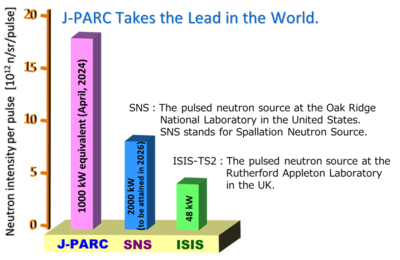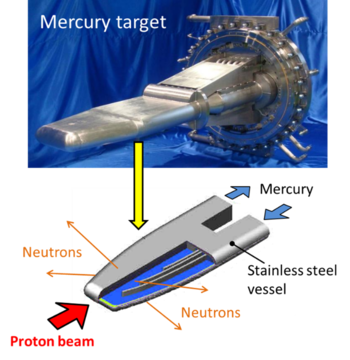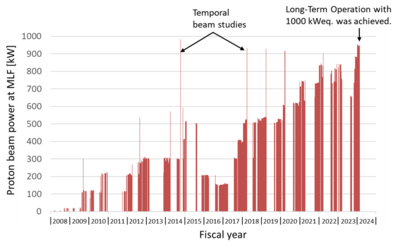The World's Most Powerful Pulsed Neutron Source at J-PARC MLF Achieved Target Performance
- Realizing Long-Term Operation at the World's Highest Intensity -
Key Points of the Announcement
∗ The pulsed neutron source at J-PARC's Materials and Life Science Experimental Facility (MLF) achieved its long-term operational goal of "continuous operation with a proton beam power equivalent to 1000 kW" starting from April 8, 2024.
∗ The neutron intensity per pulse has reached more than twice that of the SNS in the United States, which is the next highest intensity pulsed neutron source in the world.
∗ As a result, it is expected that advanced research in material science and life science using pulsed neutrons will be further accelerated and developed.
Figure 1 Comparison of pulsed neutron source performances in the world
Abstract
The pulsed neutron source※2 at the Materials and Life Science Experimental Facility (MLF) in J-PARC※1 generates pulsed neutrons with the world's highest intensity by directing a proton beam※3, accelerated to near the speed of light, at a mercury target※4 (Figure 2). This reaction shatters the atomic nuclei of the mercury. Increasing the output of the proton beam produces more neutrons, thereby accelerating experiments and research using neutrons. Experiments using pulsed neutrons are an extremely effective method for conducting advanced research in material science and life science. Major countries worldwide, including the United States, EU nations, and China, are competing to develop high-output, high-performance pulsed neutron sources.
Inside the mercury target, mercury constantly flows at a velocity of approximately 1 m/s. The powerful proton beam interacts with the mercury nuclei to generate a large number of neutrons.
Figure 2 Mercury target and internal structure
The MLF pulsed neutron source was designed with the goal of injecting a proton beam with the power of 1000 kW. Since operations began in 2008, we have gradually increased the beam power by continuously improving and verifying various equipment, including the mercury target. Starting on April 8, 2024, we commenced operations at an equivalent beam power of 1000 kW, achieving long-term operation for over 50 days (Figure 3).
The muon source, installed upstream of the MLF pulsed neutron source, has also achieved the world's highest intensity and long-term operation simultaneously.
Going forward, we will continue to accumulate stable operational performance, promote facility advancements including extending equipment longevity, and contribute to generating more research achievements.
Figure 3 History of proton beam power at MLF
※1 J-PARC
The high-intensity proton accelerator facility jointly operated by the Japan Atomic Energy Agency (JAEA) and the High Energy Accelerator Research Organization (KEK). J-PARC stands for Japan Proton Accelerator Research Complex.
※2 Pulsed neutron source
A device that generates a large number of neutrons in a short time of one millionth of a second, which is the pulsed neutrons, and repeats this process. The J-PARC MLF has the capability to generate pulses 25 times per second.
※3 Proton beam
Protons accelerated close to the light speed using an accelerator. The higher the power of the proton beam, the more protons enter the mercury target, resulting in more neutrons being produced.
※4 Mercury target
A device in which mercury flows inside a stainless-steel container, and neutrons are generated through nuclear reactions with mercury by irradiating it with proton beam.



